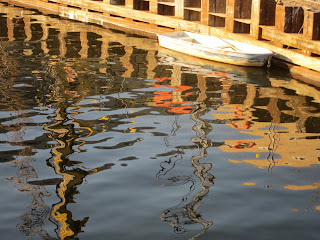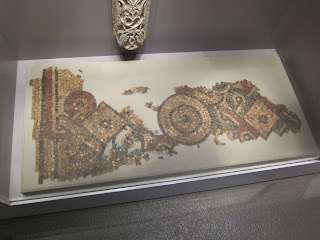Andrew and I took a trip to the Pergamon on Museum Island in Berlin. It is a renowned ancient history museum, and has beautiful Greek, Roman, Turkish, and Islamic artifacts. It contains reconstructions of actual buildings from ancient times, that must have been shipped piece by piece and reassembled in situ. This made me feel quite uncomfortable. I don't know why, for me, entire buildings are different from artifacts, but I really felt that it was wrong to have these entire buildings living in a museum in Germany, rather than located where they were originally situated. I think perhaps it was more obvious to me on this visit because I had just travelled from places such as Ankor Wat, and the Taj Mahal, and I could directly compare how sad it would be if parts of these were taken and reconstructed elsewhere. However, a beautiful museum, and we could appreciate it regardless of the complexities of ownership and colonialism.
The outside of the museum retains marks from World War II air raids, and during World War II, many items from the museum were taken by Russia. Some of these have been returned, and others have as yet not been. And therein lies more ownership conflicts.
The site, Museum Island, is beautiful, and allows the building to be right next to the water. You have to cross a bridge to enter this museum. There was a small rowboat docked next to the building, and I thought it would have been fun to row up to it, instead of cross the bridge. However, it was not to be :)
One of the first views after you enter the building is that of the Pergamon Alter. The designs on the alter show the battles between the giants and the gods, and also shows events from the life of Telephus, the supposed founder of the city, Pergamon. This structure was taken from what is modern day Turkey, and was justified by archaeologists as saving it from destruction. This may be, or this may not be, but while beautiful and wonderful to see, it is hard to think about a church or cathedral or temple from one's own town, being taken to be displayed in a museum in another country.
Another amazing structure housed in this museum is the Ishtar Gate, an entrance to the city of Babylon. The gate has thousands of glazed blue tiles (ps. why has this architectural practice disappeared? Amazing)! And raised depictions of animals. It is so beautiful. The closeup below is of a dragon.
In fact, throughout the museum, I really enjoyed looking at all of the mosaic techniques. There are so many different ways to use tessella.
This is the Market Gate of Miletus. A structure built initially in about 120 AD.
Here are a couple miscellaneous items I thought were beautiful, but didn't take notes as to what they were (oops).
And lastly, a museum within a museum. There was a wonderful exhibit showing the "Tell Halaf Adventure" in which a museum of artifacts collected by Max Freiherr von Oppenheim which were destroyed during World War II by an aerial bomb, and nearly 60 years later, a massive restoration project began which pieced together the artifacts from 27,000 fragments. That is one giant puzzle. I can't imagine doing the work that these restorers did . . . but in some ways these sculptures were even more beautiful because of it.
This is a picture of a picture of the restoration process . . .
The layout of the exhibit was especially beautiful, and added to it, I think.
Anyways--debate away--to museum or not to museum. That is the question. I say yes? tentatively? But not everything. Hmmmm.
The outside of the museum retains marks from World War II air raids, and during World War II, many items from the museum were taken by Russia. Some of these have been returned, and others have as yet not been. And therein lies more ownership conflicts.
The site, Museum Island, is beautiful, and allows the building to be right next to the water. You have to cross a bridge to enter this museum. There was a small rowboat docked next to the building, and I thought it would have been fun to row up to it, instead of cross the bridge. However, it was not to be :)
One of the first views after you enter the building is that of the Pergamon Alter. The designs on the alter show the battles between the giants and the gods, and also shows events from the life of Telephus, the supposed founder of the city, Pergamon. This structure was taken from what is modern day Turkey, and was justified by archaeologists as saving it from destruction. This may be, or this may not be, but while beautiful and wonderful to see, it is hard to think about a church or cathedral or temple from one's own town, being taken to be displayed in a museum in another country.
Another amazing structure housed in this museum is the Ishtar Gate, an entrance to the city of Babylon. The gate has thousands of glazed blue tiles (ps. why has this architectural practice disappeared? Amazing)! And raised depictions of animals. It is so beautiful. The closeup below is of a dragon.
In fact, throughout the museum, I really enjoyed looking at all of the mosaic techniques. There are so many different ways to use tessella.
This is the Market Gate of Miletus. A structure built initially in about 120 AD.
Here are a couple miscellaneous items I thought were beautiful, but didn't take notes as to what they were (oops).
And lastly, a museum within a museum. There was a wonderful exhibit showing the "Tell Halaf Adventure" in which a museum of artifacts collected by Max Freiherr von Oppenheim which were destroyed during World War II by an aerial bomb, and nearly 60 years later, a massive restoration project began which pieced together the artifacts from 27,000 fragments. That is one giant puzzle. I can't imagine doing the work that these restorers did . . . but in some ways these sculptures were even more beautiful because of it.
This is a picture of a picture of the restoration process . . .
The layout of the exhibit was especially beautiful, and added to it, I think.
Anyways--debate away--to museum or not to museum. That is the question. I say yes? tentatively? But not everything. Hmmmm.






















There are so many cultural artifacts that have literally been stripped or captured during wars, smuggled out of the country of origin, and then end up in a museum 10,000 miles away. It's a crazy concept.
ReplyDeleteI kind of understand Egypt's hard-core protection of their antiquities, especially considering how much has already been smuggled out of Egypt. I blame the Brits ;)
Yeah... there's something creepy about museums sometimes. Reliving a colonial or conquering past and displaying such prizes. Sometimes former colonies get their stuff back, but often they don't. On the other hand, first-worlders who see other civilizations as backwards and primitive can see the real beauty that existed. I agree. Mosaics need to make a comeback. From your pics tho, how weird to see these gates, which were presumably outside, inside a big building.
ReplyDelete